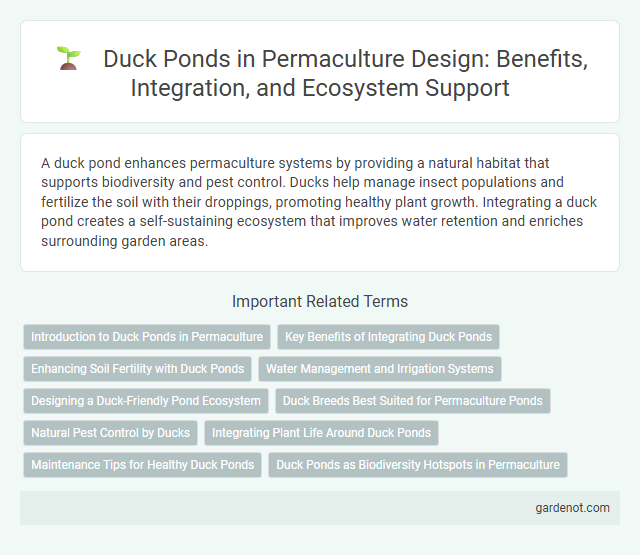A duck pond enhances permaculture systems by providing a natural habitat that supports biodiversity and pest control. Ducks help manage insect populations and fertilize the soil with their droppings, promoting healthy plant growth. Integrating a duck pond creates a self-sustaining ecosystem that improves water retention and enriches surrounding garden areas.
Introduction to Duck Ponds in Permaculture
Duck ponds in permaculture serve as dynamic ecosystems that enhance biodiversity and natural pest control by attracting beneficial insects and amphibians. These ponds provide essential water sources for ducks, which contribute to soil fertility through nutrient-rich droppings while helping to manage weeds and pests in surrounding garden areas. Integrating a duck pond supports sustainable water management and creates a self-regulating habitat that promotes balanced, resilient agricultural systems.
Key Benefits of Integrating Duck Ponds
Duck ponds increase biodiversity by providing habitat for aquatic plants, insects, and amphibians, enhancing ecosystem stability within permaculture designs. They contribute natural pest control as ducks consume mosquitoes, snails, and crop pests, reducing the need for chemical interventions. Nutrient-rich duck droppings improve soil fertility and promote healthy plant growth, making duck ponds a sustainable resource in permaculture systems.
Enhancing Soil Fertility with Duck Ponds
Duck ponds significantly enhance soil fertility by introducing nutrient-rich water high in nitrogen, phosphorus, and potassium, which are essential for plant growth. The presence of ducks promotes natural pest control and aerates the pond ecosystem, resulting in nutrient cycling that enriches surrounding garden soils. Integrating duck ponds into permaculture systems creates a sustainable microhabitat that boosts soil organic matter and microbial activity, improving soil structure and fertility.
Water Management and Irrigation Systems
Duck ponds play a crucial role in permaculture water management by naturally regulating water flow and providing irrigation through sustainable means. Their design promotes efficient water retention and distribution, reducing soil erosion and enhancing moisture levels in surrounding crops. Integrating duck ponds with irrigation systems creates a symbiotic environment that supports biodiversity while optimizing water resources for agricultural productivity.
Designing a Duck-Friendly Pond Ecosystem
Designing a duck-friendly pond ecosystem involves integrating natural vegetation such as cattails, water lilies, and submerged aquatic plants to provide shelter, food, and breeding grounds for ducks. Incorporating gentle sloping banks and shallow areas encourages easy access and safe foraging, while maintaining water quality through natural filtration with biofilters or floating plants supports a healthy habitat. Creating a balanced ecosystem with diverse species enhances nutrient cycling and minimizes the need for chemical interventions, ensuring sustainable duck pond management within permaculture principles.
Duck Breeds Best Suited for Permaculture Ponds
Khaki Campbell, Indian Runner, and Cayuga ducks are among the best breeds suited for permaculture ponds due to their excellent foraging abilities and adaptability to diverse environments. These breeds contribute to pest control by consuming insects and weeds, enhancing pond ecosystem health and supporting sustainable food production. Their hardy nature and high egg production make them valuable assets in integrated permaculture systems.
Natural Pest Control by Ducks
A duck pond integrated within permaculture systems serves as an effective natural pest control method by attracting ducks that consume mosquitoes, snails, and other harmful insects. Ducks help reduce the need for chemical pesticides, promoting a healthier ecosystem while enhancing biodiversity. Their foraging behavior maintains pond cleanliness and balances aquatic habitats.
Integrating Plant Life Around Duck Ponds
Integrating plant life around duck ponds enhances ecosystem balance by providing natural filtration and habitat diversity. Aquatic plants like water lilies and cattails improve water quality by absorbing excess nutrients and stabilizing pond edges to prevent erosion. Surrounding the pond with native vegetation attracts beneficial insects and offers shade, promoting a healthier environment for ducks and supporting overall permaculture design.
Maintenance Tips for Healthy Duck Ponds
Regularly remove debris and excess algae from the duck pond to maintain water clarity and prevent harmful bacteria buildup. Implement natural filtration systems, such as aquatic plants and biofilters, to enhance water quality and reduce the need for chemical treatments. Monitor water levels and ensure proper aeration with fountains or pumps to support a healthy ecosystem and promote duck well-being.
Duck Ponds as Biodiversity Hotspots in Permaculture
Duck ponds in permaculture serve as biodiversity hotspots by providing essential habitats for diverse aquatic plants, insects, amphibians, and bird species. These ponds enhance ecosystem health through natural water filtration, nutrient cycling, and pest control, supporting higher levels of biological diversity. Integrating duck ponds promotes a resilient and self-sustaining environment that benefits both agricultural productivity and wildlife conservation.
Duck pond Infographic

 gardenot.com
gardenot.com